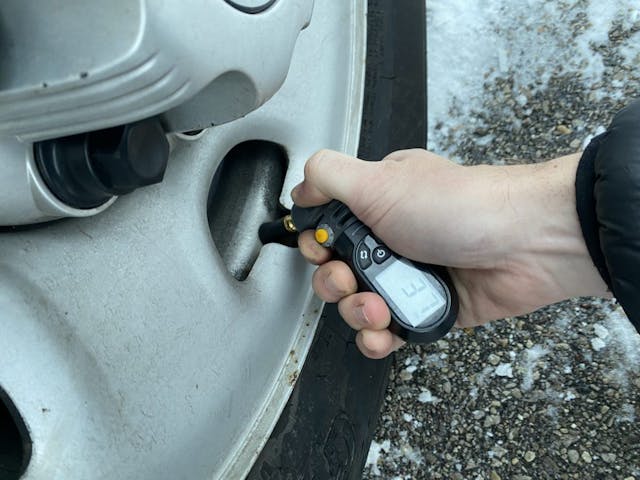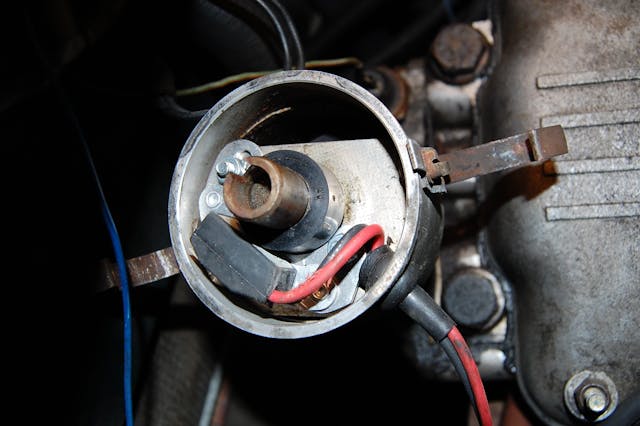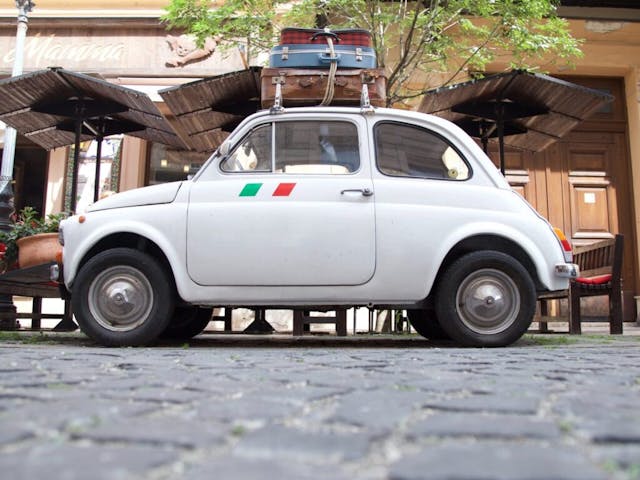How to optimize fuel economy in your classic car
A great way to reduce your classic car’s impact on the planet is to make sure it’s in tiptop running condition. Obvious, right? Not always.
This summer, many folks will hop in their family hand-me-down and fire it up for a drive without thinking about routine checks (or easy upgrades) that can help reduce its thirst for fuel.
We’ve gathered a handful of tips here. The best news? The same changes that optimize your classic’s fuel economy can improve its ride and increase its engine’s performance. More responsible habits … and more fun behind the wheel.
Tell us which measures you recommend in the comments section below.
Check tire pressure

Set your tires to the correct pressure whenever you can. You can improve your gas mileage by up to 3 percent in some cases by keeping your tires inflated to the proper pressure. Under-inflated tires can lower gas mileage by about 0.2 percent for every 1 psi drop in the average pressure of all tires. Properly inflated tires are also safer and last longer. Tire-pressure information should be visible either on the driver’s-side door jamb, the inside of the glovebox door, or in the owner’s manual. DO NOT use the maximum pressure on the tire’s sidewall.
Stay in tune
Take your car to your mechanic for a tune-up, or do it yourself! On many classic cars it’s straightforward, fun, and educational. (Read a whole host of DIY content here.) Check the spark plugs and plug wires, tune the carburetor if your car has one, and check the ignition timing.
Consider fuel injection

If your car has a carburetor, companies such as Edelbrock, Holley, and others offer electronic throttle-body fuel-injection setups that offer superior overall performance, even at full throttle. Our own Davin Reckow saw the results for himself. And when properly installed, no one will know it’s there except you.
Breathe easier
A new air filter can improve both fuel economy and acceleration by a few percentage points under normal replacement conditions. Replacing a clogged air filter on vehicles with fuel-injected, computer-controlled gasoline engines—such as those manufactured from the early 1980s to the present—or diesel engines may not improve fuel economy (as the computer can compensate for the restricted airflow), but a fresh air filter will restore power that was lost from the clogged one.
Kick it into overdrive

If you own an older collector car—especially if it’s a muscle car—and want better fuel economy, consider installing a new manual transmission with overdrive. There are complete manual five- and six-speed transmission packages from Modern Driveline. Gear Vendors has bolt-on overdrive packages for a wide range of vintage cars with manual or automatic transmissions. These are overdrive systems you can install in a collector car and only you will know it’s there. When overdrive is in engaged, your engine will turn significantly slower at higher speeds, ensuring your car sips fuel rather than gulps it. And five- and six-speed manual transmissions often have less rpm drop between gear changes than most original gearboxes, so your car will accelerate better, too.
Breaker, breaker

If you drive a collector car that is still using breaker points in its ignition system, you’re very likely burning excessive amounts of fuel, while also dealing with the maintenance issues associated with these older systems. The electronic-ignition conversions from companies such as PerTronix, Mallory, and Accel are easy to install and improve both drivability and fuel economy. Every time a spark plug misfires, precious fuel is lost via the tailpipe. Electronic-ignition conversions virtually eliminate misfires when properly installed.
Drum technique

If your classic has drum brakes (which it most likely will if it’s more than 40 years old), they can be adjusted too tightly, which causes drag, and will result in your car consuming more fuel.
Keep it smooth
Try to drive with gentle and deliberate inputs. Spend less time accelerating and more time at cruising speed, without resorting to jackrabbit starts, unsafe driving, or any other questionable tactics. Maintain a steady speed without heavy application of throttle or brakes. Anticipate traffic and brake accordingly. Avoid excessively high speeds. Coast to decelerate rather than relying on heavy application of the brakes.
Drive with purpose
Avoid unnecessary idling or carrying extra weight.

***
Check out the Hagerty Media homepage so you don’t miss a single story, or better yet, bookmark it. To get our best stories delivered right to your inbox, subscribe to our newsletters.


All pretty good stuff, but to me – after riding with a lot of other folks – the most “unknown” idea seems to be: “Anticipate traffic and brake accordingly. Avoid excessively high speeds. Coast to decelerate rather than relying on heavy application of the brakes.” Easily 70% of the people I see in traffic (and that I’ve ridden with) get going as fast as they can and then have to mash the brakes, when it is apparent from far back that slowing and/or stopping (for traffic or stop lights, etc.) will be needed. I have been a huge proponent of coasting to save brake life for a long time.
I suppose my days as a long-haul truck driver contributed to my looking far ahead and reading what traffic and/or road conditions might be well before I get there. Trying to jackrabbit start and panic stop 80,000 pounds will get a person in trouble REALLY quickly. I’ve found that smooth, gentle applications of pressure on both throttle and brakes will not only improve mileage, but safety as well. That seems obvious – but observation of most folks out there proves that it’s seldom heeded, if at all.
To DUB6: EXCELLENT advice!
You’re sadly correct, in that most “drivers” really don’t know how to.
Keep on preaching!
Rare advice indeed. My dad was a “million miler” owner/operator of dump trucks and heavy equipment. Anything that broke, he’d have to fix (or teach me to), so he was a master at babying the rolling stock. Planning the run when carrying loads was paramount. You didn’t “let her out” until the road was clear for a long steady run, and you did your slowing down well in advance, never braked on a bind, never hit the tracks at an angle. You just don’t meet many drivers who think that way any more. There were three views of life in those days: on by the hour, on by the mile, and on by the ton.
I call them stab, jab, and grab drivers.
Stab at the gas, jab at the brakes, and grab at the wheel.
I also see people slowing down a hill, then continue to coast up the other side until they get the steepest part of the hill then hit the gas.
Years of driving slow cars has taught me to preserve momentum.
I have done all of these, except for installing an overdrive transmission. Unfortunately, my V12 XJS still gets fewer miles per gallon than my 4 cylinder Malibu. What am I doing wrong? 😉
Why would anyone hold back from answering a question, if the answer were “Laycock-deNormanville”?
We have a 1982 C10, 305, automatic. With the anti pollution equipment removed it got 10 mpg. When I removed the monster air cleaner and plugged all hoses, then installed a smaller air cleaner the mileage went up to 14-15!
Sounds like the carburetor was poorly tuned to start with. Removing pollution control equipment doesn’t free up that much energy. A 305 doesn’t need a very big air cleaner when cruising anyway. Be happy.
@DUB6, I agree, I always look ahead and hate the people who just mash their brakes so much.
I found keeping your momentum going and being smooth and deliberate keeps the fuel economy happy. Works everywhere it is tried.
@DUB6…More agreement here.
With a little proper planning, situational awareness, and energy management, it’s amazing how little the brakes are actually needed, even in traffic. And in a vehicle that gets poor economy to begin with, little changes in habit can have an even greater effect. Our ’01 Durango R/T (with 5.9 engine) is the worst guzzler in the stable, but can top 16 mpg on the highway if driven like there’s an egg under your right foot. The Acura Vigor can top 32 mpg on the highway when driven prudently, even though the EPA has it rated at 26mpg highway.
Being familiar with your automatic transmissions programming can help also. The 46RE here goes into 4th and then converter lockup at 35mph (behind a V8), whereas the daughter’s 42RE won’t get 4th and converter lockup until 48 mph, due to being behind a 6 cylinder.
My younger brother used to say; “To get better gas mileage, go to the junkyard (midwest slang) and get a Cadillac coil spring, and put it under the footfeed.
AAA says properly inflated tires can save drivers 8 cents a mile.
I say properly cast votes would have saved drivers three dollars a gallon.
Amen. As the saying goes you may not be interested in politics but politics is interested in you.
thats 1 of the best comments I’ve heard
AMEN
All is good advice. However, with my Hummer H2, when I follow that advice, I can go from 9 mpg to about 10.5 mpg. Hmmm… 🙂
Think of it this way… That is a 16.6% increase in economy! It is the same as going from 30MPG up to 35MPG.
Agree with all the above about the jack rabbit, get to the light while it’s still red, not looking ahead beyond 10′ in front of the car. What also helps is to time the lights, where it is done for us. Unfortunately not all cities time their lights, and that causes untold amounts of congestion (and fuel waste). An obvious mileage breaker as I noticed on the last photo of the Fiat 500 with the roof rack loaded up pretty high. Years ago when I had a 1968 VW Bus, we decided to take a trip up North from Phoenix. Roof rack with 2 bikes on it, and hauling a tent trailer, were able on the flat to only do 45 mph. Stopped to evaluate the situation, and removed the bikes from the roof and put them in the tent trailer. Starting up again, we easily got back up to 65mph. Would do 50 up the mountains until someone cut in front and slowed us down, and there wasn’t enough power to get back up to speed, so it was into the right lane and slog the rest of our way up to the top. Wind resistance can be a bummer in more ways than one!
All good advice, but we’ve long wondered why the owners of old domestic cars seem oblivious to the dictum “weight is the enemy,” even while fawning over relative prosaics –other than coachwork — like the ’52-on Bentley Continental, in which weight loss, as well as longer legs, were the keys.
I shed over a 100 lbs. from an already well-engineered Packard of the Forties, which despite leaving the factory with overdrive, I switched to the slightly taller differential used in those shipped sans OD. Radial instead of bias tires help, as well as driving smoothly, avoiding freeways even in such vintage iron still capable of “doing the ton (100 mph),” as the English put it.
Thanks, tho’ as we all know, few among the collector car crowd will heed it.
So what’s wrong with determining air pressure by what’s listed on the tire? The car doesn’t know what kind of tire is mounted. Almost all modern tires ( which are radial) are maxed at 44 psi. My 56 Hawk’s manual recommends 26 and 24, front and rear ( bias ply) . You see my point.
By your logic the tire doesn’t know what it’s mounted on. Your situation is unique, as the tire is different from the one that was selected by those who designed and engineered the vehicle. So yes, if you change the system it is now up to you to properly engineer and determine the proper tire pressure. Also, to say all modern radials are maxed at 44psi could be true for some sizes and tires, but is broadly wrong. I can think of dozens of examples of radial tires that can and do utilize higher pressures than that–and safely.
Speaking of fuel economy, has anyone driven one of those newer vehicles that has the auto engine shut-off when you come to a complete stop? Just wondering if there is much of a fuel savings with them. I’m thinking that the possible money that you save now might be used later to repair or replace the starter motor due to its increased use.
While the fuel savings would probably not cover a starter replacement, I am pretty sure that the engine shut off feature is measured in carbon reduction, not fuel savings.